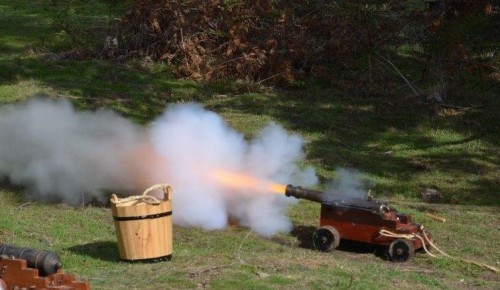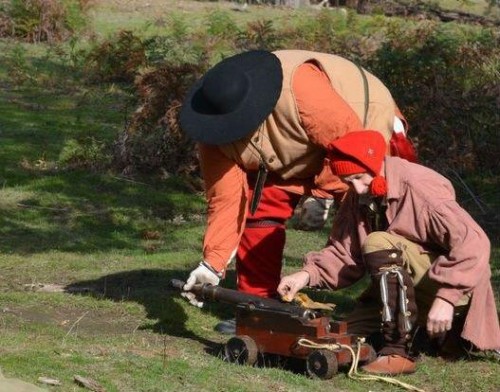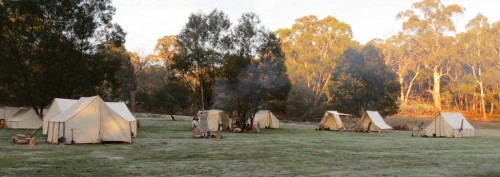Vol. 45, July 2013
 1 response already
1 response already

Winter Quarters, Queen’s Birthday holiday weekend: The campsite was filling rapidly by Friday afternoon in anticipation of a first rate weekend with fine weather forecast for the next four days; and our Weather Bureau did not disappoint. By Saturday morning a dozen primitive style camps of white canvas filled the Painted Pony Plain at Bernard’s Cache.
Attending our Winter Quarters (in approximate order of arrival) were Peter Convey, Paul Sly, Ian Convey, Tom Jefferies, Chook Fowler, John Sultana, Michelle Barraclough, Bob Ellis, Charlie Timma, Mark Pountney, Rob Powell, Murray Convey, Gary & Jenny Baker, Cameron Cowled, Sven Wylie, and Justin Fletcher.
Jim Walker could not make it due to minor eye surgery and a resultant one week driving ban. The warm winter days were accompanied by chilled and frosty nights, so in the absence of Jim, Peter was elected chief fire-stoker and we all kept snug and comparatively smoke free in the open faced shelter. Tom took over Jim’s wood cutting role and ample supplies of good dry wood were soon piled high.

Bob Ellis had devised and constructed a very effective “Running Fox” target featuring a steel life-size fox that passed from left to right with a limited visual time span. Moving targets were quite new to many of us and proved an exciting challenge to all. A total of 60 shots from a dozen shooters in this five shot event saw the target well peppered with round ball dents. Most impressive were the shoulder grouping of Ian’s shots and one beautiful neck shot from Michelle. After three hits apiece, a shoot-off was necessary between Ian and Bob, with Ian taking final honours on pest destruction.

Card Shoot – eleven shooters took part; eleven playing cards were stapled face down to eleven stakes. The suite of hearts was used from Ace to the 10 spot plus the Joker. No one knew what value card they shot at until the end. Under the pretence that the idea was to shoot a good group everyone was surprised to learn that it was actually a “Luck Shoot” and that the shooter who flipped over the Joker would be riding with Lady Luck on this occasion. Mark Pountney won a powder horn that had been donated by John Maccioni and then very nicely titivated-up by Ian.
Knife and Hawk: The Hawk event seems to have a cult following status for some chuckers. The bruised handle cult, the broken handle cult and the obvious “those that practice-a-lot cult”. But it’s all great fun. After five throws Bob, Mark and Peter were level pegging and the game got more serious. Peter was the eventual winner while Bob once again proved too good at the Knife throw just pipping Charlie this time.
Bernard and Judy visited for the evening entertainment and we all once again enjoyed Bernard’s speciality coal fired Damper with Judy’s home-made jams. Ian’s guitar playing and song repertoire continues to improve and grow – “he practises a lot!”
The Mud Bash Rovers from over the hill were unusually quiet this year but no one complained about that. Nothing wrong with quiet!

Sunday morning saw Paul out early for a last chance at ducks prior to season closure. A cannon demonstration had been promised for this morning. Just two cannon were brought along but they were received with total interest and attention to the loading and firing technique. Jenny’s signal cannon has a 1.18” bore and fires via an uncomplicated cord operated cap-lock. The second cannon was a ¼ scale Cook cannon having a .75” bore and fired using standard safety fuse and linstock. A number of members took turns at loading and aiming and both cannon delivered surprising accuracy.

After lunch a Missouri Boat Ride shoot – a length of rope strung between two trees to be cut in two in the centre; a 3 shot event at 20 yards. Someone shoved Peter Convey to the head of the row of shooters, so Peter quipped “I’ll show y’all how it’s done” and cut that rope with his very first shot. After re-tying the rope everyone took turns for their three shots but to no avail. Even Peter couldn’t bust that string again and there was no carpet-bagger to spit upon to ease frustrations.
The next event was a team effort “Can Push” starting out at about 15 yards with water filled cans. Ian divided the teams into roughly even calibres, one big bore, one medium and one small bore for each team. On the left was Ian & Peter Convey and Mark Pountney; the centre team consisted of Tom Jefferies, Cameron Cowled and Jenny Baker; while on the right was Bob Ellis, Michelle Barraclough and Chook Fowler. Rob Powell was calling the shots for the Lefties, Gary Baker was assisting Jenny loading, while John Sultana was speed loading for Michelle on the right.
There were many encouraging shouts as first one team then the next shot those cans further and further away. Oh, there was much laughter as one can spun onto its side and rolled backwards a few feet. Then great excitement as the 10 minute time-limit approached and the cans were seemingly in a neck and neck race. With just seconds to spare it was Chook’s last shot that caused that can to leap two feet ahead of all opposition for a resounding win. But everyone wins in terms of fun experienced on these easy and so simple to organise shoots. “Don’t ya wanna have fun no more?”

A Good Day in the Field
The sun slowly lifted over the treetops and its warm rays started to melt the heavy frost that was covering the ground and my kettles, axes and all the gear I’d left outside next to the fire pit. It was time to get out of bed, grab some coals from the communal fire pit and coax some wood to catch alight and get some hot coffee brewing.
With the warmth of the flames starting to drive the chill out of my bones, the toasting wire was put to use and the frying pan with some strips of bacon and an egg. Before long the sizzle and pop of bacon cooking, the smell of the coffee bubbling away and the toast browning nicely soon made me forget about the icy morning air, at least temporarily.
Having consumed a hearty breakfast it was time to slip on the hunting shirt, game bag, hunting pouch, powder horn and shot flask and stretch the legs for a mornings walk. The destination being a couple of farm dams nearby, to see if any ducks were on them; it was the last week-end of the Victorian duck season. I made a wide loop to approach the first dam and slowly raised my head above the earthen bank. Ahead on the opposite side of the dam were two wood ducks, a rather long shot for my flintlock smoothbore “Precious”.
It was not long before the ducks realized that my head was not part of the landscape and flew off. I shouldered “Precious”, put some lead on the male wood duck and squeezed off the shot. After the smoke had cleared the two ducks were still high-tailing it over the top of the trees and were showing no sign of turning back.
At the sound of that shot some movement caught my eye to the right and there on the next dam, close by, was a small mob of chestnut teal. They lifted into the air for a short distance and landed back in the middle of the dam. I crouched down, retraced my steps, and then dropped down into the gulley that was at the end of the dam. I quickly reloaded and quietly made my way up to the bank and looked over the top.
Due to the morning calm broken by that first shot these teal were on high alert. As soon as I showed my head over the bank they were up in the air. I picked out the closest bird to me and fired, soon after a satisfying splash was heard. But there was no time to dwell on that shot; with a hasty reload and the pan primed I was ready for the birds as they were coming past. I gave the front bird some extra lead and squeezed off the shot. Smoke belched from Precious and a second bird splashed into the water.
As I reloaded again, the ducks had started to look for safer waters and were out of range, but one decided to come back for one last look. It had caught me by surprise and the shot was a hasty one, but one pellet found its mark and broke the wing bone on the left side. With a “controlled” splash landing the duck was looking about with a bemused expression as if to ask why it had suddenly landed on the dam.
Quickly I threw down a measured amount of powder, the wads and shot into the barrel and with a quick check that all was safe on the other side of the dam I dispatched the wounded bird. Getting the ducks out of the water without going for a swim proved a challenge. With no strong breeze to push them across the surface it came down to throwing sticks. After a few (read many) good throws the birds were finally close enough to collect at the water’s edge and stow into the game bag.

With an extra spring in the step I returned to camp and field dressed two of the birds and put them in cool safe place and the younger looking bird I prepared it so I could have it for dinner that night with some butternut pumpkin, Brussels sprouts and potatoes. The meat was tender and certainly a satisfying meal to round off a good day in the field and to finish off the last hours of the duck season.
Le Reynard
Cannon and camp ovens
How often do we hear laments about how most household and workshop chattels are made in China these days? These regrets often carry a suggestion that such goods are of inferior quality. But it ain’t necessarily so! Just because the labour rates may be cheap does not automatically reflect on quality while it could be said that today’s black powder users and campers have reason to praise ancient Chinese technology.
For example, the discoveries of gun powder and of cast iron manufacture! Over time other countries have further developed and improved on the formulas but we at least owe some acknowledgement to the Chinese for the invention of black powder and for our camp (Dutch) ovens and other similar cast-iron cookware.
According to Wikipedia forging cast iron was first invented in China sometime between the 4th and 6th century BC. The molten metal was poured into moulds to make ploughshares and pots as well as weapons and pagodas. In the west, where it did not become available till the 14th century, its earliest uses included cannon and shot.
Henry V111 initiated the casting of cannon in England. Soon, English iron workers using blast furnaces developed the technique of producing cast iron cannons, which, while heavier than the prevailing bronze cannons, were much cheaper and enabled England to better arm her navy. As for camp ovens – many consider our 20th C. Aussie made brands far superior to the Asian products and the very best available.

Having great fun
Had a phone call from Ian saying that he had some chores to do on his son-in-law’s farm so decided to combine work and pleasure. He took his flinter, powder, ball, pouch and possibles and after completing the farm chores he put up a target and had a really great time blazing away, making lots of smoke and noise. He was really enjoying the outing, until he walked up to check out his target. What the…. Aw, hell!
More practise needed!

Coming Events
Sat. 13th July Ballarat Arms & Militaria Collectors Society Fair (“Gun Show”) The Free Trappers support this event each year through the Council of Muzzleloaders. We share a table with the Seymour Black Powder Club and the Western Districts Club to promote all things black powder. Tables at the hall are booked out, so this year promises to be a huge event for collectors and all firearm enthusiasts.
10th / 11th August – Beechworth’s Ned Kelly Festival. Tent display and dress 1880’s. A chance to dress up and share the fun in historic Beechworth.
14th / 15th September – Spring R’voo – at Bernard’s Cache. A “traditional” pre 1840 Primitive weekend. (NB. The 15th is the “traditional” 3rd Sunday of the month.) This is the big one! Over the past few years many of us have extended this weekend taking in the Friday before and the following Monday just to extend the good times. Book those extra days and just be there.
Thanks again for the newsletter, it is always fun reading about your events. You are getting cold down there while here (Idaho) the days are getting to the extreme, 115′ F down to the southern end of the state and we have been up to the high 90′. No rain in sight. I guess we are all seeing the results of what the scientists call global warming. I think that it’s a natural cycle in the worlds history. The story about calibers brought a chuckle, I guess I need to get rid of the 32,45,50,54, 62 and look for a 70. I think it should go the other way. Good luck in your coming shoots and keep yer eye on the skyline and yer powder dry. sloe Bear (Preston, Idaho)